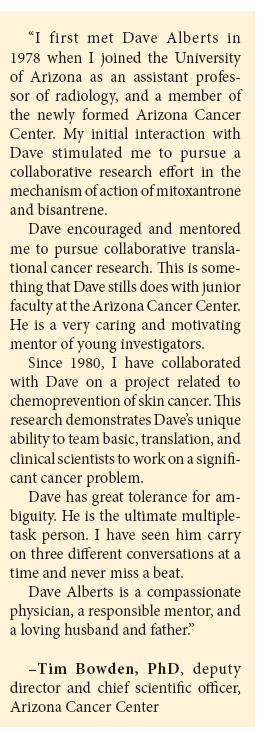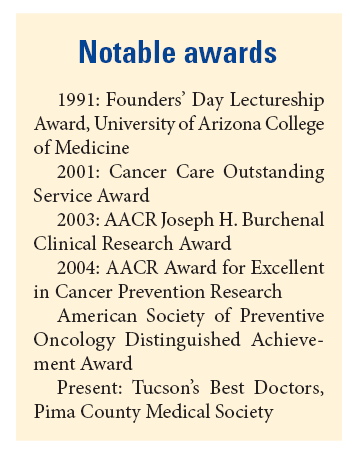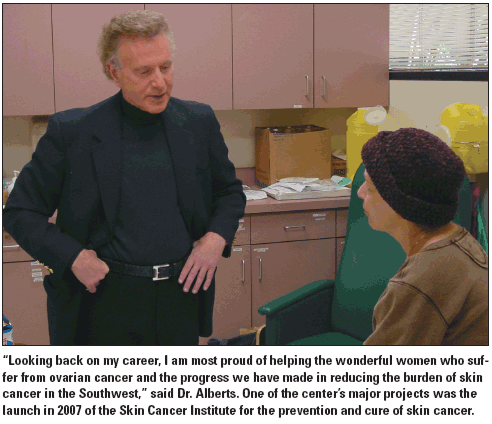David Alberts: Survival of the fittest
Desert living presents many challenges: extreme weather, lack of water, unfriendly cacti, and lethal creatures. Adaptability plus a strong survival instinct are key. David S. Alberts, MD, has plenty of both. When he relocated to the University of Arizona, he’d just finished up five years at the University of California, San Francisco, pouring his efforts into leukemia and myeloma research.
ABSTRACT: Diverse career keeps focus on single-minded devotion to science and its effect on quality of life.
Desert living presents many challenges: extreme weather, lack of water, unfriendly cacti, and lethal creatures. Adaptability plus a strong survival instinct are key. David S. Alberts, MD, has plenty of both. When he relocated to the University of Arizona, he’d just finished up five years at the University of California, San Francisco, pouring his efforts into leukemia and myeloma research.

Once in Tucson, he had to jockey for a place on the academic food chain. “My colleague said, ‘Dave, I’m the leukemia guy.’ Another said, ‘I’m the myeloma guy. Those are off-limits for you.’ I said, ‘OK, what’s left?’ They said, ‘Pelvis.’ So I became the GI oncology and the GYN oncology guy,” Dr. Alberts told Oncology News International.
It’s one of many instances in his career when Dr. Alberts has successfully improvised to thrive. From his start as a clinical pharmacologist to his current position as the director of the Arizona Cancer Center, Dr. Alberts has never let trying circumstances get in the way of achieving his goals.
Serious illness, serious student
Dr. Alberts grew up in Milwaukee as an athlete with a passing interest in academics. At age 13, he was diagnosed with ulcerative colitis, an experience that transformed him. “I used to be a four-letter athlete, and there I was, completely knocked out by this illness,” he explained. “Fortunately, corticosteroids came on the scene for the disease and I was able to turn it around. It had a huge impact on me. I was amazed with the medical profession and how well I was treated.”

Dr. Alberts buckled down and set his sights on medicine. A career in cancer research seemed preordained: His 36-year-old father had survived colon cancer, while his grandfather died of the same disease. His grandmother and mother battled breast cancer (as did his wife Heather Alberts).
“I have a horrendous family history with cancer,” he said. “So that was something I always kept in mind.”
Putting research into practice
Dr. Alberts’ CV is 100-plus pages of landmark achievements in internal medicine, clinical pharmacology, hematology/oncology, colon cancer, public health, nutritional sciences, cancer prevention, and, of course, ovarian cancer. His endeavors in academia have been multifold as a student, investigator, scholar, editor, author, and teacher (see Table on cancernetwork.com).
Dr. Alberts attended Trinity College in Hartford, Conn, earned his MD from the University of Virginia in Charlottesville, returned to his home state for an internship at the University of Wisconsin-Madison, served as a clinical associate at the NCI’s Baltimore Cancer Research Center, and completed his residency at the University of Minnesota in Minneapolis. His academic appointments include numerous clinical instructorships and professorships, many at UCSF.
In 1975, he accepted an invitation from Sydney Salmon, MD, to help build the Tucson-based cancer center. Thirty years later, Dr. Alberts took over the leadership of the NCI-designated comprehensive cancer center for the entire state.
As varied as his career has been, there is a dominant theme, explained Maurie Markman, MD. Dr. Markman collaborated with Dr. Alberts (along with Stephen Howell, MD, at University of California, San Diego) on the research and trials that ultimately led to the NCI issuing a 2006 clinical announcement supporting postsurgical intraperitoneal (IP) over IV chemotherapy in advanced ovarian cancer.
“I don’t know anybody more passionate about the impact of research on our patients,” said Dr. Markman, vice president for clinical research at Houston’s M.D. Anderson Cancer Center. “Dave’s goal was that research should always improve survival and the quality of lives of the patients.”
The situation that led him to become “the GI and GYN oncology guy” ultimately met Dr. Alberts’ goal to always put science to work in the real world.
“I wanted cancers that were opportunities for phase I drug development,” he explained. “Ovarian cancer continues to be the most chemosensitive cancer that we deal with. It’s a high-mortality cancer that is incredibly sensitive to drugs. Virtually every new cytotoxic drug is first studied in ovarian cancer patients. We have very long median survivals despite the high mortality rates: 22,000 new cases and 16,000 deaths a year. In our center, the median survival is over six years. It’s good, but we need to be curing a higher percentage of these women.”

Dr. Alberts’ contributions to ovarian cancer treatment are far-reaching. Along with the UK’s Hilary Calvert, MD, Dr. Alberts helped develop carboplatin for gynecologic tumor treatment and was involved in the trials at the Arizona Cancer Center. In addition, Dr. Alberts oversaw the Southwest Oncology Group and Gynecologic Oncology Group through major IP trials. “It’s still a struggle . . . to get IP therapy established as an absolute for woman with stage III, optimally debulked disease. We conducted three big studies that showed a median survival improvement of more than 12 months with IP chemotherapy,” he said. “But we haven’t adequately trained our oncologists on how to do IP.”
Good to treat; better to prevent
In 1989, Dr. Alberts was director of the clinical pharmacology section when he received a summons from the boss: Dr. Salmon wanted him to start a cancer control program. “I said, ‘No, I’m running the pharmacology program.’ So Dr. Salmon took me to the chair of the department of medicine who said, ‘Dave, you’re going to start a cancer prevention and control program, or you are never going to get another raise as long as you are here.’” “I put out an SOS to the entire university faculty and called a meeting-three people showed up: cancer biologist Tim Bowden, PhD, nutritional anthropologist Cheryl Ritenbaugh, PhD, and a biostatistician” he added. “I thought that was a pretty good start. I said to Dr. Salmon, ‘What resources are you going to make available to start this program?’ He said, ‘None.’”
Dr. Alberts and colleagues were unfazed; they created skin and colorectal cancer prevention project grants, both of which are active today as part of a broader cancer prevention and control program. In the last five years, the programs have garnered close to $40 million in federal grants.
Dr. Alberts credits much of his success to teamwork: An interdisciplinary approach isn’t just a good idea-it’s the only way to truly advance research. “I’ve been surrounded by phenomenal talent,” he said. “The way that I’ve been able to accomplish things is team science. I’m not a big believer in structure because it can inhibit the development of science. You need to allow the real talents of your faculty to develop.”

All-around cancer education
Cancer prevention and education remain areas close to Dr. Alberts’ heart. One program that he is particularly proud of is “Better Than Ever.” Developed by Mrs. Alberts, the program helps cancer survivors train for local bike races and marathons. Also, “Healthy Children Arizona,” is geared toward elementary school kids with an emphasis on physical activity, nutrition, and sun safety. Its centerpiece is a series of puppet shows, partially designed by Sabrina, Dr. Alberts’ daughter.
As much as Dr. Alberts loves science, he is a firm believer in the lifestyle-cancer risk link. Not enough effort has been put on revamping “our terrible Western lifestyle: sedentary in front of the TV, eating foot-long subs and chocolates. Obesity is a rapidly growing problem that correlates with cancer risk,” said the fitness buff, who logs daily sessions on his stationary bike and enjoys walks with his wife.
He is also on a mission to teach future generations of medical professionals how to make that transition from laboratory-based research to clinical trials.
“With the big push in translational research, we need training programs that bridge the chasm between basic research and clinical research. Basic scientists need to understand the clinical side and vice versa. I think more emphasis needs to be put on training because it’s not going to happen by osmosis,” said Dr. Alberts, who serves as the principal investigator on an NCI-funded, cancer prevention and control training grant.
It’s a job he is well suited for, according to Dr. Howell. “David is a perpetual well of enthusiasm and very effective at clearly and cogently communicating new concepts to his colleagues and students,” he said. “David has encouraged and mentored a whole new generation of clinicians in the field of drug development and clinical trials research.”
Dr. Alberts still has a cancer center with more than a dozen research sites throughout Arizona to run, 300 physicians and scientists to collaborate with, and multiple grants and projects to oversee. The 34-year desert dweller is up to the challenge. “In a viable academic career, it is essential to reinvent oneself about every 10 years, or the science and career become stale,” he said. “I think medicine has to be fun. You want to wake up in the morning cancer-free and say, ‘I’m a lucky person.’ I’ve been very fortunate to pursue such a meaningful career.”
Newsletter
Stay up to date on recent advances in the multidisciplinary approach to cancer.